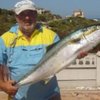I have enough trouble as it is landing big cob - or any cob for that matter - from the surf, and the idea of spinning for them and expecting to actually get a strike really frightens the living daylights out of me, but after seeing 2 cob of 15kg being landed on ESA tonight by the guest angler from PE made me think a bit.
Doing some research on this form of catching cob brought very little information, and there are no pictures I could find on the Havoc lures, but after reading what anglers like neilg and other spinning and dropshot specialist had to say the picture became a little bit clearer.
The first important thing to do is to have a leap of faith - to get away from the conventional way of thinking and to believe, really believe, that this is possible. Come to think of it, cob in our area are normally caught on live mullet, and they are definately not a stationary target, so pulling an inviting lure slowly through the water started to make sense.
The second important issue to consider is a change of normal cob tackle. In stead of using medium to heavy tackle suitable to throw a 8 ounce sinker and bait we have to downsize to lighter tackle. Casting Rapalas or Halcos and Havocs are not the easiest thing in the world, but it does get a lot easier after you have downsized your rod, reel and line.
The best advice I could find was to change to a spinning reel and braid as soon as possible. With this setup you have way less chance of overthrows, you have a much longer casting distance even when there is a wind blowing, and the touch and feel of the braid makes even the light strikes big cob tend to make so much easier to notice.
Use a setup similar to a 10ft or 12 ft spinning reel rated to about 4 oz, match it to a 8000 spinning reel with 50 pd braid or a Daiwa 30 multiplier with .40 line and you should be set. The Havoc lures from Port Elizabeth seems to do the trick, but wide body Rapalas like the Giant Shad Raps also works extremely well. These lures with their bigger silhouette are easier for the cob to pick up, and when retrieved at slow speeds their actions are a lot better.
All geared up and with your mind set on landing monster cob on artificial lures you now have to find the perfect spot of water to test your skills. Cob are common in shallower coastal areas along sandy reefs and estuaries. Cob hunt mainly by smell and lateral line senses instead of by sight so they are very good at feeding at night and in dirty water. An ideal spot for Cob in the surf would be where you have white water breaking far out onto a sandbank with a deeper channel running just in front of it. You should wade in so that you can cast your lure onto the sandbank and then SLOWLY retrieve it back through the channel. The Cob normally swim through the channel and will also feed on the sandbank.
This is a great new facet of angling and something I am sure I will give a try in the near future.



